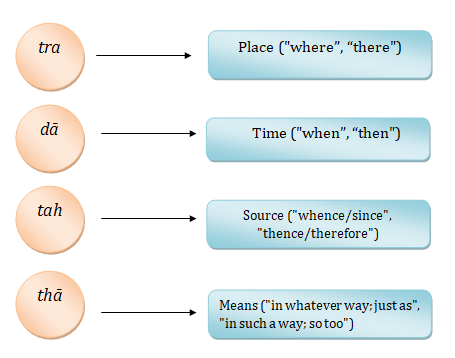Till now we have learned a basic way of making sentences. They are basic because the types of sentences that are formed are not relatable to each other. What we did till now was forming sentences with one subject and one action at a time.
You see the man who goes. I go if you go.
You smile when he stands
I go where you remember.
Relative clause
Now as we are climbing up the ladder we need to learn to make complex Sanskrit sentences and that is only possible if we use a relative clause to do so. A Relative clause joins the main clause of the sentence to the other part. They act as a sensible bridge between two sentences. For instance, in English, they are “who”, “which”, “then” etc. Similarly, Sanskrit has its own relative clauses. So let us take a look at them.
With uninflected words
-
yadi and tada
Here we’ll handle the sentence “I go if you go.” We can split this sentence into two distinct parts: “You go” and “I go.” We want to say “if you go, then I go.”
Hence, to do this we are going to use two new uninflected words “yadi” and “tada”. Where, yadi means “if” and tada means “then”
यदि गच्छसि तदा गच्छामि
yadi gacchasi tadā gacchāmi
If you go, then I go. (I go if you go.)
2.yādā and tādā
yādā means “when.” It is used the same way as yadi. tādā still means “then.”
यदा स तिष्ठति तदा त्वं हससि
yadā sa tiṣṭhati tadā tvaṃ hasasi
When he stands, then you smile. (You smile when he stands.)
As before, we can split the sentence into two parts. First, we have “you remember.” Second, we have “I go.” We want to say “where you remember, there I go.”
3.yatra and tatra
To form such sentence, we will use the following two words: yatra and tatra. yatra means “where,” and tatra, which means “there.” they appear in front of the clause that it describes.
यत्र स्मरसि तत्र गच्छामि
yatra smarasi tatra gacchāmi
Where you remember, there I go. (I go where you remember.)
From the above examples, you can notice that there are some common repetitive suffixes. But what do they mean? Well…. Let’s find out.
You must have notice that each of the suffixes resembles the noun cases; tra is similar to case 7, dā, like case 7, tah, like case 5, and tha is roughly like case 3. tra and tah, however, are quite often used with the same case meaning. That’s why you see such words in Gita:
अयोगतः
ayogataḥ
Not from yoga
With pronouns
We just learned that how to use these relative clauses with uninflected words. Now we are going to learn how to use them with pronouns. So let’s begin.
yad and tad
tad here is the same tad that we have been studying so far. It will be used for the correlative pronoun whereas; yad will be used for the relative pronoun.
Let us first consider the sentence: “You see the man who goes”. As before, we have two separate situations. First, we have “The man goes.” Second, we have “You see him.” After breaking them and applying the pronouns we get this:
यो नरो गच्छति तं पश्यसि
yo naro gacchati taṃ paśyasi
The man goes; you see him. (You see the man who goes.)
the yad part here functions like an adjective, if removed it will still make sense
तं पश्यति
taṃ paśyati
You see him.
Now let us take another example.
“You go with the man who conquers the two horses.”
We can construct these two parts separately. The first: naro ‘śvau jayati. The second: tena gacchasi. What we do now is use yad as an adjective to the relative clause’s noun, which is naraḥ. So, we get the following:
Till now in the given examples we have seen yad in the relative side. However, it can be done other way too. For instance:
यो नरो ऽश्वौ जयति तेन गच्छसि
yo naro ‘śvau jayati tena gacchasi
The man conquers the two horses; you go with him. (You go with the man who conquers the two horses.)
Now let’s take another example;
“They go with the hero whose son sings”
Let’s see how we can transform it into Sanskrit;
यस्य वीरस्य पुत्रो गायति तेन गच्छन्ति
yasya vīrasya putro gāyati tena gacchanti
The hero’s son sings; they go with him. (They go with the hero whose son sings.)
As said before, yad and tad needn’t necessarily be in the same case, but they must be of same number and gender.
One thing that is very usual and common in all these sentences is that, in every sentence, noun falls on the yad side of the sentence. However, it is not compulsory and can be interchanged. So let us see how it happens.
यो गच्छति तं नरं पश्यसि
yo gacchati taṃ naraṃ paśyasi
He goes; that man, you see.
(You see the man who goes.)
यो ऽश्वौ जयति तेन नरेण गच्छसि
yo ‘śvau jayati tena nareṇa gacchasi
He conquers the two horses; you go with that man. (You go with the man who conquers the two horses.)
यस्य पुत्रो गायति तेन वीरेण गच्छन्ति
yasya putro gāyati tena vīreṇa gacchanti
His son sings; with the hero, they go.
(They go with the hero whose son sings.)




